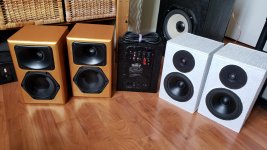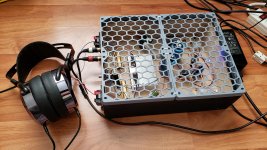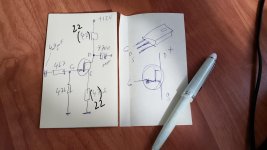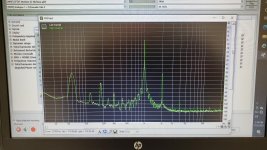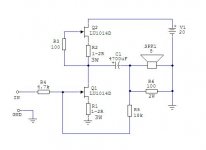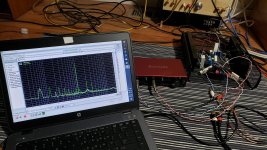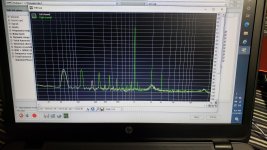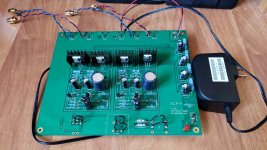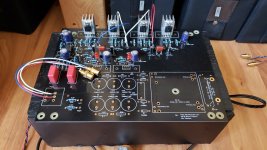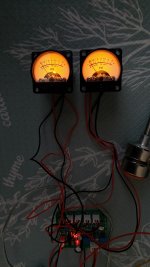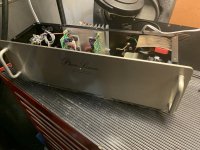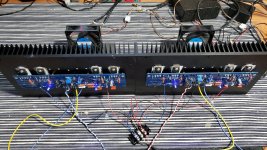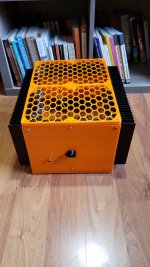Another ESP Circuit
I've been experimenting with cascading filters for speaker correction for a couple of years. My old setup is a shelving booster 40-80 Hz cascaded with a 36 dB/octave high pass filter @ 20 Hz (another ESP circuit) that works very, very well with my 8" two ways.
I was curious about this Project 197 so I built it with a 50 Hz peaking frequency. Referencing Figure 3, I made Rf2 switchable between 6.8K and 8.2K, giving 3 dB and 6 dB peaks. I put it in a small enclosure (old router box) with simple volume, bass, and treble controls, on/off switch, and 2 line level inputs. I used tiny Bourns "pro series" potentiometers which are pretty good. I used my usual Dale CMF series resistors and nice Wima film capacitors.
It runs off a wall wart, with an on board RLC filtering circuit, reverse polarity protection, and a fuse. The whole thing was built with salvage and leftover parts.
I was skeptical that such a simple circuit could do do much with so little without mucking up the sound. But this circuit certainly does a great job of equalizing woofers and of course is easy to modify. And the whole thing including volume control and tone controls uses 3-5532AP chips. Parts count is about one quarter my regular preamp (which is ultra precision fancy pant$ all the way).
I've been experimenting with cascading filters for speaker correction for a couple of years. My old setup is a shelving booster 40-80 Hz cascaded with a 36 dB/octave high pass filter @ 20 Hz (another ESP circuit) that works very, very well with my 8" two ways.
I was curious about this Project 197 so I built it with a 50 Hz peaking frequency. Referencing Figure 3, I made Rf2 switchable between 6.8K and 8.2K, giving 3 dB and 6 dB peaks. I put it in a small enclosure (old router box) with simple volume, bass, and treble controls, on/off switch, and 2 line level inputs. I used tiny Bourns "pro series" potentiometers which are pretty good. I used my usual Dale CMF series resistors and nice Wima film capacitors.
It runs off a wall wart, with an on board RLC filtering circuit, reverse polarity protection, and a fuse. The whole thing was built with salvage and leftover parts.
I was skeptical that such a simple circuit could do do much with so little without mucking up the sound. But this circuit certainly does a great job of equalizing woofers and of course is easy to modify. And the whole thing including volume control and tone controls uses 3-5532AP chips. Parts count is about one quarter my regular preamp (which is ultra precision fancy pant$ all the way).
luckily, our ears are much less sensitive in the low fr region, so any eq, or filter you introduce, will have minimal effect on the sound quality
on the other hand, if you eq it for better, it can only improve the quality of overall presentation
so I agree, correcting the room modes, or woofer roll of is important
over the years of building speakers, I learned that the outcome of my project mostly depend on the quality of mid and especially quality of the tweeter
the better the tweeter, the better result
cheers!
on the other hand, if you eq it for better, it can only improve the quality of overall presentation
so I agree, correcting the room modes, or woofer roll of is important
over the years of building speakers, I learned that the outcome of my project mostly depend on the quality of mid and especially quality of the tweeter
the better the tweeter, the better result
cheers!
True, but I've heard terrible bass from systems before; boomy and even the "monotone" woofer that only plays one note. My system doesn't boom at all - bass is super clear and acoustic music like jazz and classical sounds so clear; while it still provides the punch you in the chest bass from the kick drum when listening to rock, without boom or overhang. And the one track I listen to that has boomy bass in the mix (Zeppelin live) - it reproduces the boom perfectly!
This whole topic is anathema to hi-fi purists. Some can't even tolerate bass and treble controls. But the fact of the matter is that many (maybe most) speaker systems of reasonable domestic size can benefit from roll off correction. Plus it allows you to build a sealed enclosure smaller without sacrificing bass extension (at the expense of efficiency and max spl). Add a higher order high pass filter and you increase the max spl of the system. It's pretty easy and very effective.
I first decided to do this after reverse engineering and stripping salvaged audio electronics. Many tabletop hi-fis (like $100 for the whole system) still worked and sounded surprisingly good through their cheap speakers. I discovered that these systems were heavily equalized in order to wring the last decibel out of these speakers. I thought that this would work well with higher quality systems, and I was correct.
I first decided to do this after reverse engineering and stripping salvaged audio electronics. Many tabletop hi-fis (like $100 for the whole system) still worked and sounded surprisingly good through their cheap speakers. I discovered that these systems were heavily equalized in order to wring the last decibel out of these speakers. I thought that this would work well with higher quality systems, and I was correct.
here is my take on eq and roll of correction
many people, who use small speakers and are missing the bass to sound realistic, simply use +bass knob and add some bass
well, there is downside to this, as small bookshelf speakers starts rolling say below 50-80Hz, they only need correction below 50-80Hz
I am sure you have seen those baxandall eq curves, they start at 1kHz and go strait to treble and bass up
applying +bass overlays speakers response with baxandal curve...
so they are effectively creating the nasty hump in midbass (or upper mids)
in order to properly apply eq, one needs to use more than just +/- bass and treble
ideally, 31 band equalizer should be used, compromise would be 14 band, but anything less than that will do some harm trying to correct the roll offs
or parametric eq should be used
my old sanyo plus preamp had excellent clean sounding parametric eq
similarly some old SAE and Technics
many people, who use small speakers and are missing the bass to sound realistic, simply use +bass knob and add some bass
well, there is downside to this, as small bookshelf speakers starts rolling say below 50-80Hz, they only need correction below 50-80Hz
I am sure you have seen those baxandall eq curves, they start at 1kHz and go strait to treble and bass up
applying +bass overlays speakers response with baxandal curve...
so they are effectively creating the nasty hump in midbass (or upper mids)
in order to properly apply eq, one needs to use more than just +/- bass and treble
ideally, 31 band equalizer should be used, compromise would be 14 band, but anything less than that will do some harm trying to correct the roll offs
or parametric eq should be used
my old sanyo plus preamp had excellent clean sounding parametric eq
similarly some old SAE and Technics
Yes, I have realized all this about speaker eq. Traditional Bandaxall tone controls almost always do more harm than good, giving tone controls a bad name.
My tone controls typically have turnover frequencies below 300 Hz (even 200 Hz) and above 3 kHz. They can do much less damage this way. What speakers need boost at 500 Hz or 2 kHz? None, not even those super cheap and crappy TV speakers.
When you use a hard wired bass eq (like my 40-80 Hz shelving eq) along with tone controls, everything is better. Instead of cranking the bass control to eq the last octave (and boost a bunch of frequencies that don't need it), your bass control setting will be very close to flat - maybe a little boost - and if sorted correctly the two controls work very well together. The peaking filter works fine with the bass control too; in fact you could probably get by without it in my setup.
I've never seen a multi band equalizer I liked. They all introduce hiss, distortion , and what I call "mud" to the signal. They were very popular in the late 80s/early 90s. I didn't like them then and I don't like them now. Maybe I should build one I like, since I'm such a picky bastard.
My tone controls typically have turnover frequencies below 300 Hz (even 200 Hz) and above 3 kHz. They can do much less damage this way. What speakers need boost at 500 Hz or 2 kHz? None, not even those super cheap and crappy TV speakers.
When you use a hard wired bass eq (like my 40-80 Hz shelving eq) along with tone controls, everything is better. Instead of cranking the bass control to eq the last octave (and boost a bunch of frequencies that don't need it), your bass control setting will be very close to flat - maybe a little boost - and if sorted correctly the two controls work very well together. The peaking filter works fine with the bass control too; in fact you could probably get by without it in my setup.
I've never seen a multi band equalizer I liked. They all introduce hiss, distortion , and what I call "mud" to the signal. They were very popular in the late 80s/early 90s. I didn't like them then and I don't like them now. Maybe I should build one I like, since I'm such a picky bastard.
More projects...i got some spare stuff through swap from another diy member, some unfinished, some loose stuff.
I finished those soundgroup bookshelfs, they sound good, but a little laid back to my taste. They will make nice gift.
Loose vifa mid and hivi tweet are now foamboard bookshels, these sound better, flat, more to my taste.
2.1 dayton amp put in box, just add sub and it will be nice dorm system. I have not evaluated its sound yet, it works.
I finished those soundgroup bookshelfs, they sound good, but a little laid back to my taste. They will make nice gift.
Loose vifa mid and hivi tweet are now foamboard bookshels, these sound better, flat, more to my taste.
2.1 dayton amp put in box, just add sub and it will be nice dorm system. I have not evaluated its sound yet, it works.
Attachments
If you are not affraid of a little heat, and want more power and lower distortion, keep the upper resistor at 22ohm, but lower the bottom one to 2-4 ohms. At 2 ohms it draws more than 0.5A and while the transitor is not that hot, upper 22ohm will dissipate some heat.
At 3 ohm lower resistor its manageable. 4 ohm is comfortable zome. It still has pure second harmonic, nothing else, it sounds great, can even power small bookshelf easily.
At 3 ohm lower resistor its manageable. 4 ohm is comfortable zome. It still has pure second harmonic, nothing else, it sounds great, can even power small bookshelf easily.
Attachments
Here is another lu1014 power jfet based amp/headphone amp. Its Juma's circuit. This is true amp, great design, nice sound. Definitely must try.
I started to explore the circuit with 8 ohm resistors, just to find out how it works. Then started lowering the bottom resistor to 2-3 ohm, for manageable heat dissipation.
Distortion is much lower than previous simple circuit. This one is not only sporting better current source with upper lu1014, but even some sort of feedback. I do not pretend to understand it completely, ask Juma.
Nice little amp.
I started to explore the circuit with 8 ohm resistors, just to find out how it works. Then started lowering the bottom resistor to 2-3 ohm, for manageable heat dissipation.
Distortion is much lower than previous simple circuit. This one is not only sporting better current source with upper lu1014, but even some sort of feedback. I do not pretend to understand it completely, ask Juma.
Nice little amp.
Attachments
I was totally wrong in post #92, covid is not over thanks to omicron variant
So i will keep posting in thus thread...
Since both, ACP+ and Whammy are such a great sounding headphone amps and can be used as preamp, I built one more of each. Likely one goes to a friend of mine.
Both work from start, just need boxes. (Hardest part for me)
So i will keep posting in thus thread...
Since both, ACP+ and Whammy are such a great sounding headphone amps and can be used as preamp, I built one more of each. Likely one goes to a friend of mine.
Both work from start, just need boxes. (Hardest part for me)
Attachments
Last edited by a moderator:
I’ve been tempted to do the same thing to a headphone amp, should be cool. I like the warm illumination.
A recent project here was the resurrection of an old Phase Linear 200 amp that was in perfect cosmetic condition. Being a turd of an amp, it had sat on a shelf for years, was free to me.
Another free receiver had its digital processing fail, an Onkyo TX-SV919. The amplifier was still in great shape, and being an early THX specced product, I thought it was worth saving, appeared to have some matched parts, higher quality caps. The main chassis and front channels of the Onkyo went to a shop space where I work, and the rear/surround channels were removed as a module.
That module fit right into the Phase Linear 200 carcass, and using the original transformer ahead of another yielded the 44v for the amp module. Another drop from the last transformer was utilized to make a dedicated 5v supply for a Bluetooth receiver.
A CLC filter between the transformers helps with line noise.
A pair of Infinity Primus 150 speakers with blown tweeters sounded pretty good with the newly assembled rig.
After digging through a box of jbl surround speakers that had small drivers along with tweeters, it was discovered that the tweeters were the same dimensions, yet were 6.7 ohm versus the 3.2 ohm of the blown Infinity ones. After a bit of adjustment (remove series R ahead of HF crossover, new poly caps, add r to drivers) of the crossover, the Primus 150s are sounding great for use in a main area together with the retro Franken-amp.
A recent project here was the resurrection of an old Phase Linear 200 amp that was in perfect cosmetic condition. Being a turd of an amp, it had sat on a shelf for years, was free to me.
Another free receiver had its digital processing fail, an Onkyo TX-SV919. The amplifier was still in great shape, and being an early THX specced product, I thought it was worth saving, appeared to have some matched parts, higher quality caps. The main chassis and front channels of the Onkyo went to a shop space where I work, and the rear/surround channels were removed as a module.
That module fit right into the Phase Linear 200 carcass, and using the original transformer ahead of another yielded the 44v for the amp module. Another drop from the last transformer was utilized to make a dedicated 5v supply for a Bluetooth receiver.
A CLC filter between the transformers helps with line noise.
A pair of Infinity Primus 150 speakers with blown tweeters sounded pretty good with the newly assembled rig.
After digging through a box of jbl surround speakers that had small drivers along with tweeters, it was discovered that the tweeters were the same dimensions, yet were 6.7 ohm versus the 3.2 ohm of the blown Infinity ones. After a bit of adjustment (remove series R ahead of HF crossover, new poly caps, add r to drivers) of the crossover, the Primus 150s are sounding great for use in a main area together with the retro Franken-amp.
Attachments
I do not know where else to post this, so I will place it here.
As we always need to keep an eye on the temperature, and I personally do not like to run things too hot, for long term reliability, I run classA amplifiers with forced air. Most of the time I run small DC fans with reduced voltage to make them quiet. Off course you need to select voltage high enough so they start and run reliably. I have tested some available fans, and I recently came across these, 24 volts dc. They are absolutely quiet at lower volts, force quite a lot of air, and they are very cheap. So that you know, if you are looking to have forced air around your amp.
https://www.parts-express.com/Globe...09A-Lock-Rotor-Protected-with-12-Lea-259-2024
As we always need to keep an eye on the temperature, and I personally do not like to run things too hot, for long term reliability, I run classA amplifiers with forced air. Most of the time I run small DC fans with reduced voltage to make them quiet. Off course you need to select voltage high enough so they start and run reliably. I have tested some available fans, and I recently came across these, 24 volts dc. They are absolutely quiet at lower volts, force quite a lot of air, and they are very cheap. So that you know, if you are looking to have forced air around your amp.
https://www.parts-express.com/Globe...09A-Lock-Rotor-Protected-with-12-Lea-259-2024
- Home
- Member Areas
- The Lounge
- viral projects, sort of
